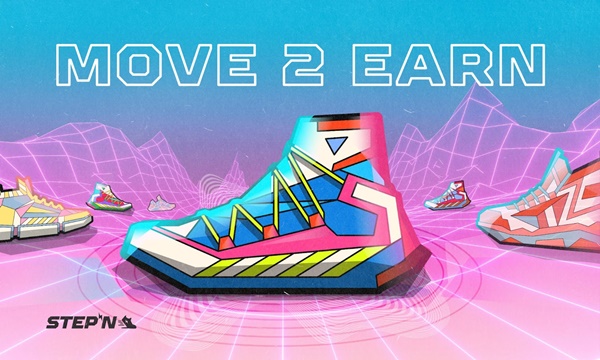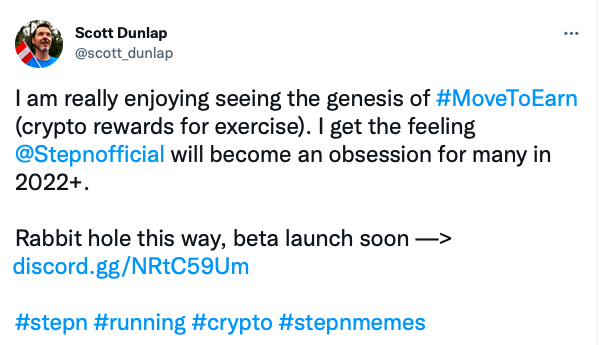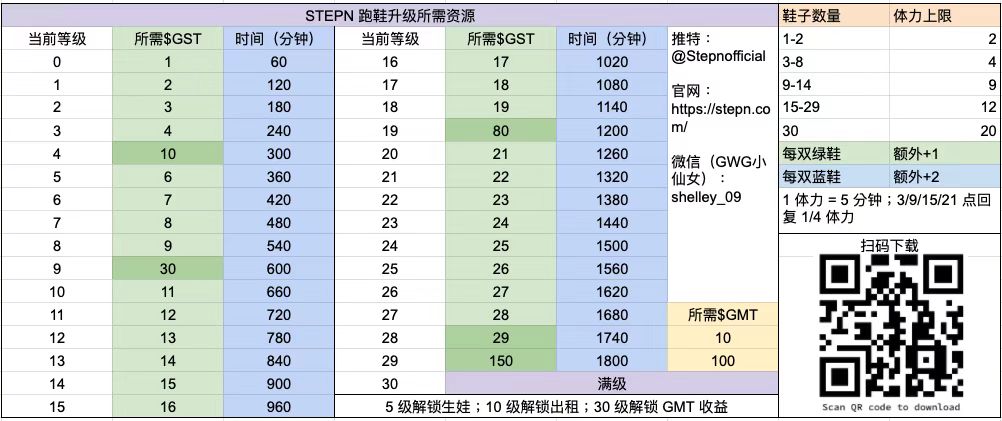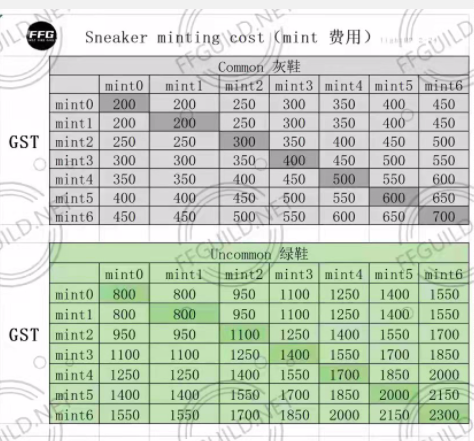Author | Qin Xiaofeng
Editor | Hao Fangzhou
Produced | Odaily

Author | Qin Xiaofeng「STEPN」Editor | Hao Fangzhou
Produced | OdailyIn the past few months, the most popular chain game in the GameFi market is undoubtedly. The game is built on the Solana blockchain and is known as the world's first Move To Earn (earn while moving) NFT game.
In January of this year, "STEPN" announced the completion of a US$5 million seed round of financing, led by Sequoia Capital India and Folius Ventures, which became famous for a while; recently,
Binance Launchpad
Announced that the STEPN governance token GMT will be launched soon, which once again ignited the enthusiasm of chain game players.
The core model of "Qubu" is a Ponzi scheme that pulls people's heads and pays dividends, and the tokens continue to be issued without consumption scenarios. In the end, the price collapsed and the project ran away. "STEPN" does not rely on the development of offline newcomers, has developed a variety of sports gameplay, and designed a variety of token application scenarios, and finally achieved a dynamic balance between token casting and destruction.
"STEPN's goal is to push millions of people to live a healthier lifestyle, bringing them into the Web 3.0 world, while making a positive contribution to carbon neutrality." STEPN official said.
Is the innovative gameplay of "Move To Earn" really reliable? Can the cutting-edge player "STEPN" in the chain game market succeed in getting out of the circle like "Axie Infinity" and bring growth to the encryption market? Odaily has personally experienced this game, and will analyze the economic model and development prospects of the project in depth below.Scott Dunlapfirst level title

(1) Web3 chain game "STEPN", popular overseas
"Excited to witness the origin of "Move to Earn", I think in 2022, more people will be obsessed with STEPN. "Recently, Vice President of Adidas and CEO of Runtastic
Posted on social media. This is not the first time Scott Dunlap has praised STEPN. He has tweeted many times before to promote the project, saying that "STEPN will become the dark horse of the industry in 2022."
There are plenty of STEPN bulls like Scott Dunlap. In the past few months, many fund managers and encrypted KOLs have become STEPN's "tap water" and recommended this chain game to users inside and outside the circle. They either gave affirmation on social media, or wrote articles introducing gameplay and analyzing economic models:
"It's such a simple design. People equip NFT sneakers and then earn tokens by walking or running. The game has a full decentralized wallet built into the game, with SWAP exchange, cross-chain conversion functions, and comprehensive anti-cheat mechanisms , to prevent being exploited.” Mike Dudas, former Google Wallet executive and partner of 6th man venture capital firm, said.
“STEPN is the first game of its kind, full of gamification and mobile earning mechanics. Soon, every runner will be earning Tokens and collecting NFTs as they track their progress. Crypto incentives, NFT collectibles, and the real world This intersection of utilities gives us a scenario where the physical and digital worlds converge in the future,” said Dan Patterson, Partner at Sfermion Fund.
STEPN is a Move To Earn NFT game based on the Solana public chain. It previously won fourth place in the Solana "Hackathon" chain game section and received an official Grant reward.
The Move To Earn game is a new form of GameFi where players use their movement data as gamification input and are then rewarded with tokens and NFTs.
"As early as early August last year, STEPN came up with this idea. Although it was not the first project to propose the concept of M2E, STEPN was the fastest project to "realize" this idea. It took only 120 days to complete it. Product delivery. ’ said the STEPN team.
According to the official website, in November last year, STEPN launched a beta version. More than 1,000 players from 43 countries were invited to participate in the beta phase, achieving a weekly player retention rate of more than 70%. In January, the download volume of STEPN in the Japanese app store surpassed that of Nike, detonating overseas forums. Currently, STEPN has more than 30,000 daily active users and is known as the next "Axie Infinity".(1) Diversified gameplay, jumping out of the homogeneous competition of blockchain gamesThe basic gameplay of STEPN is very simple. Players equip NFT sneakers in the game application to participate in the game; they can earn token income by running in the real world, and the income can be used to upgrade and repair sneakers to improve the efficiency of "earning coins". Can be sold directly.
The specific operation steps are as follows, players first need to
STEPN official website
Download the mobile application STEPN App, register a STEPN account via email; after registration and login, players can create or import an existing Solana wallet in the game, and transfer SOL from the trading platform to the wallet address, so that they can be used in the game Buy NFT sneakers and get in-game rewards in .
Players can purchase NFT sneakers in the app market. There are four different types: Walker (walker), Jogger (jogger), Runner (runner) and Trainer (trainer). Different types of shoes have certain restrictions on the player's speed. For example, the speed limit of Walker is 1-6 km/h. If it exceeds the corresponding range, the movement will not generate token income. Different types of shoes have different prices, and Trainer is the highest because it has the widest speed limit range of 1-20 km/h.
Each type of sneaker is divided into 5 qualities, divided into: Common (common, gray), Uncommon (rare, green), Rare (rare, blue), Epic (epic, purple) and Legendary (legendary, orange ). Shoes of different qualities have different attributes, and the token income generated is also different.
After purchasing NFT sneakers, players can officially participate in the game. Gameplay includes:
Single-player mode: Players can start running by clicking "Start" on the game page, thereby earning tokens; under the same conditions of NFT sneakers, the longer the exercise time, the more tokens they will get. Of course, there is a certain limit to the daily exercise time ("energy"). Once it is used up, the earning of tokens will stop. The analysis of the economic model will be highlighted later.
· Forging new shoes: Players can use two pairs of sneakers with a level of 5 to forge new shoes. Each sneaker has 7 chances to forge new shoes; each time a shoe box is cast, players can directly put it into The NFT market can be sold, or you can open it yourself to continue upgrading and casting new shoes.What is quite interesting is that when the new shoes are cast, there will be a "mutation". Even two pairs of ordinary shoes can be cast into high-quality, other types of shoes. Some players said in the community that they used two pairs of Common shoes to cast a pair of Uncommon shoes and sold them directly, earning thousands of dollars.
· Rental of sports shoes: If you have a lot of sports shoes in your hand, you can rent out the shoes that reach level 10; during the rental process, no deposit is required, but the NFT cannot be transferred out of the account; STEPN will charge 8% for the final distribution The tax rate, while the lessee and lessor income distribution fixed ratio is 3/7. The rental gameplay can cooperate with the future gold-making studio, and the revenue will be shared, which will bring a lot of money to NFT players.
In addition to the above three ways of playing, STEPN will also open a marathon mode, players can choose to participate, and finally get a lot of money based on the ranking. In addition, the background mode will be supported in the future, players can earn GST without opening the STEPN App, and the background of the App will directly obtain the number of steps from the health data of the player's mobile device.
(Note: For specific gameplay and rule introduction, you can click to jump to read related articles)
(2) Some problems still need to be improved
"The STEPN game design is really good, but it is a bit laborious. Sometimes when you walk without swinging your arms and put your phone in your pocket, there will be some gaps in the data, resulting in a reduction in the number of coins you earn. "Player A responded to Odaily.
In fact, the root cause of the above-mentioned problems lies in the design of the anti-cheating mechanism of STEPN games. In order to prevent players from falsifying their movement conditions and gaining improper benefits, STEPN uses gravity sensors to obtain players' movement conditions. In different sports states, the "wavelength" of human motion is significantly different, thus proving the authenticity of the player's motion.
In addition to the above problems, some players also reported that STEPN is often unable to count steps or the data is inaccurate in some underground passages or office buildings. STEPN said that these problems are mainly caused by unstable GPS signals, and there is no ready-made solution yet, but they have studied a new set of algorithms-in the latest Beta test, compared with traditional running applications and GPS devices Compared with GPS, its GPS accuracy has increased by 70 times.
In the game, players need to transfer the SOL in the wallet address to the spending account (Spending Account) in the game system, so that they can buy NFT sneakers in the game and get game rewards. However, sometimes the wallet transfer takes a long time, and the operation of the two accounts is inconvenient, and the built-in wallet transaction is occasionally not smooth; and the existing NFT market display is relatively chaotic, and the historical records cannot be viewed. In response to these problems, the recent official announcement will merge consumer accounts and wallets in the next version upgrade, and upgrade the NFT market to facilitate user transactions.
Finally, some players reported that the NFT floor price has risen from the initial 1-2 SOL to the current 8-10 SOL, and the price of the token GST has risen, which has led to an increase in the game cost of new players and a longer payback period. Of course, this problem reflects the rising popularity of the game to some extent. This is also a common problem faced by all chain games in the rising period, and it is difficult to effectively solve it at present.
first level title
(2) Is Stepn a copy of "Qubu"?
For those who love sports, the "Move To Earn" model has indeed brought a lot of income to this group. This also made STEPN an instant hit, quickly out of the circle, and became the new darling of the chain game market.
However, STEPN's model has also been interpreted by some users as "sports is mining", which is reminiscent of the popular game "Qubu" a few years ago. There are also some doubts that STEPN is a replica of Qubu and will eventually collapse inevitably. But is this really the case? Will STEPN repeat the same mistakes?
STEPN believes that the fundamental reason for the failure of Qubu and other similar projects is that the project party has not found a mechanism for balancing token minting and burning, and the emergence of GameFi just solved this problem. To this end, STEPN has designed a more complete economic model, adopting a dual currency model.
First, analyze the economic model of Qubu. The gameplay is that players need to invest in scrolls, and candy tokens are generated through scrolls and activity; if new users are invited to buy scrolls, they can get higher activity and thus higher income. The end result is that the game becomes a head-to-head relay race that defeats the original purpose of the sport. In addition, Qubu’s candy tokens continue to be issued, there is no consumption scene, the price falls in a waterfall, and eventually the stampede crashes. In two years, the number of victims of Qubu has increased to 120 million, and Qubu has also been investigated by the police in many places for alleged pyramid schemes, illegal fundraising, and financial fraud.
The most essential difference between the STEPN model and Qubu is that players do not need to pull people to go offline, and do not issue rewards for invited users; STEPN sets up multiple application scenarios through the dual-currency model, increases token consumption, and constantly sets up "obstacles" Reduce output so that additional issuance and consumption form a dynamic balance.
In terms of output, STEPN has set a daily output cap. The GST and GMT that players can earn daily are limited. Initially, they can only earn a maximum of 5 GST per day to start the game, and then upgrade their sneakers After that, the daily GST limit can be increased to 150; while the GMT daily limit is 5.

In terms of usage scenarios, the main uses of GST and GMT are as follows:
1. Upgrade the shoe level. Players can upgrade their sneakers from Lv1 to Lv 28 by burning in-game GST, but the number of Tokens required for the upgrade will increase exponentially with the increase of the sneaker level; upgrading from Lv28 to Lv30, in addition to burning GST , also need to burn GMT. The consumption tokens required for upgrading at each stage are as follows:
image description
2. Speed up the upgrade time. Each upgrade takes time. For example, it takes 30 hours to upgrade from level 29 to level 30. Some users can choose to accelerate the upgrade. At this time, GST is also required as a token, and the cost of each level of acceleration is different, showing an index level growth.

3. Sneaker repair. Every time you use NFT to run, the shoes will wear out (out of 100 points, it will continue to decline). Once the wear rate is higher than 50%, the efficiency of token generation will also drop significantly, which also means that players have to constantly maintain sports shoes. GST is The basic token for maintaining shoes has a strong rigid demand.
4. Synthesize new shoes (Mint). Normal, green and blue shoes need to consume GST when performing Mint; while purple and orange shoes need to consume GMT for Mint. As the number of Mint increases, the number of tokens required also increases linearly. For example, two pairs of regular shoes with 0 Mints and the first Mint need 200 GST, which is currently about $700. The specific data are as follows:
image description
(Image source: ff guild.net)
In addition to the major functions mentioned above, GST can also unlock gem slots (gems can add skill points to shoe attributes), upgrade gems and wash points for sneakers.
GMT can be used for high-end in-game activities, such as rebranding sneakers and advanced upgrades; more importantly, GMT can be used for game governance. The profits in the game are voted in the form of DAO, and GMT holders will decide how much of the game profits will be used for carbon neutrality as a reward to pay them. At the same time, by locking GMT in the profit pool, players will also get higher voting rights.
Many people may compare GST and GMT in STEPN to SLP and AXS in "Axie Infinity", but there is still a big difference between the two.
SLP is minted in a unified way, there is no continuous destruction of tokens, only in specific application scenarios will be destroyed (babies), which will cause tokens to be generated faster than consumed and lead to inflation, and when game developers Intervening more in the game economy will irreversibly change the market's expectations for external intervention, making external intervention less and less useful. STEPN iterated on the basis of its predecessors, and designed various "token application scenarios" for paying players, allowing "krypton gold" players to fully burn their tokens; at the same time, it also took care of players without NFT and provided them with access to The game provides windows (rental system).
"By carefully analyzing the economic model of Axie Infinity's native token SLP, we have made it clear where the challenge of game token design is - if the supply of game tokens is unlimited, how to balance supply and demand? From Keynes to Hayek, from code We have researched everything from currency circulation to network effects.” The STEPN team said, “We found that the unified minting of game tokens must be managed through the unified destruction of game tokens to convert them into different forms of assets. Can be voluntary, mandatory, or structured. Temporary minting of game tokens must be managed through consumption of game tokens to create value beyond currency.”
The final result is also as the team envisioned. After the GST went online, the price was running smoothly without skyrocketing or plummeting. Affected by market sentiment recently, some new users began to hoard GST, causing the price to rise to $3.5.
To sum up, STEPN has set up a dual-token economic model: on the one hand, it creates diversified scenarios for GST and GMT to improve ease of use; at the same time, it controls the output of GST and GMT to reduce selling pressure. It is difficult for players to simply seek rent through mining and selling, and the return on assets is implicitly limited and diversified. This solves the previous problems of blockchain games to a certain extent, and helps prevent the game from falling into a death spiral in a bear market, which is precisely the biggest hidden danger faced by most blockchain games.
(3) Paradigm shift from P2E to M2E
In 2021, "Axie Infinity" will be popular in Southeast Asia, expanding the "earn while playing" P2E beyond the encrypted community, allowing more people to understand GameFi blockchain games. The emergence of "Stepn" also set off a wave of change in the blockchain game industry: a paradigm shift from P2E to M2E.
From the perspective of gameplay, in the past, chain games had higher professional requirements for players, and players needed to learn relevant skills, and some gold-making studios even specially trained players. STEPN focuses on a more detailed "M2E" concept, with a broad base of people and low operating thresholds. Players don't need a lot of operations. They only need to click start on the homepage and start exercising to participate in the game.
For users outside the blockchain circle, the learning cost is relatively high. If the blockchain game adds a lot of cumbersome operations, it will inevitably further hinder traditional users from entering the blockchain world. From this point of view, STEPN is undoubtedly more friendly to users outside the circle.
In STEPN's view, "M2E" has a broad market space. According to a survey data mentioned on the project's official website, in 2017, 55.9 million people in the United States alone will participate in running, and 111 million people will participate in walking fitness; in 2021 , the online fitness industry has achieved an annual growth rate of 33%, and if it can expand in this area, it means that M2E games can drive millions of people into the Web 3 market. So, to further promote the concept, STEPN has previously sponsored two charity runs in Australia.
“Different from the Play to Earn games we have seen, the Move to Earn project has created a system that connects the chain world with the real world more closely. It is no longer to encourage players to earn income, but to let them click on the page with almost the same mechanism design, but to fully mobilize their enthusiasm for sports, provide them with passive income, and exercise their bodies at the same time. ’ said the STEPN team.
More importantly, adhering to the values of low carbon and health, STEPN has also made its own contribution to the cause of global carbon neutrality.
According to the official plan, GMT holders will decide through a community referendum how STEPN distributes the proceeds of the project treasury to purchase Carbon Removal Credit on the chain so as to support the global carbon neutral cause more openly and transparently. Additionally, users can voluntarily choose to donate their GST - which will be exchanged for USDC/fiat to purchase carbon neutral credits or burned.
first level title
(4) Summary
Every game has its own life cycle, and it is very difficult to keep a game alive for a long time. In order to solve this dilemma, most games continue to introduce new and diverse gameplays in an attempt to retain old players. However, repeated version iterations have gradually pushed up the learning cost of new players.